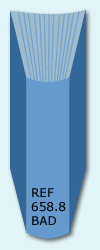| Catalogue| | Home| | Student tips| | Checklist |
 |
|
|
|
||
|
||
 Call
numbers
Call
numbersThe call number of an item indicates the shelf location of the item.
All catalogue records will have a call number. The call number tells you where you can find the item on the shelf.
When checking the catalogue record, it is important to note down the entire call number and the branch at which the item is held if you want to be able to find the item on the shelf.
Call numbers are made up of three elements or codes: the prefix, the Dewey number and the suffix.

